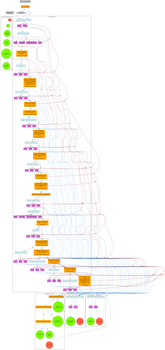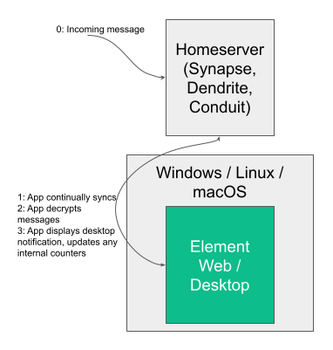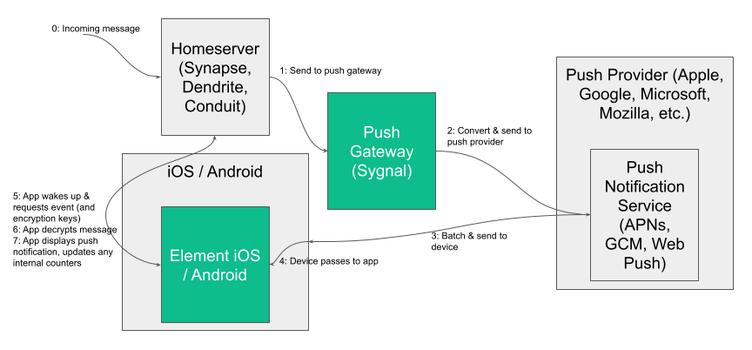Matrix Push Rules & Notifications
In a previous post about read receipts & notifications in Matrix I briefly mentioned that push rules generate notifications, but with little detail. After completing a rather large project to improve notifications in Matrix I want to fill in some of those blanks. [1]
Note
These notes are true as of the v1.6 of the Matrix spec and also cover some Matrix spec changes which may or may not have been merged since.
Push notifications in Matrix
Matrix includes a push notifications module which defines when Matrix events are considered an unread notification or highlight notification [2] and how those events are sent to third-party push notification services.
Push rules are a set of ordered rules which clients upload to the homeserver. These are shared by all device and are evaluated per event by the homeserver (and also by clients). Default push rules are defined in the Matrix spec. Push rules power the unread (and highlight) counts for each room, push notifications, and the notifications API.
Each rule defines conditions which must be met for the rule to match and actions to take if the rule matches.
Processing of push rules occur until a rule matches or all rules have been evaluated.
Getting notifications
As some background, clients receive notifications in one of two ways, via polling /sync and/or via push notifications.
Web-based clients often receive events via polling:
The sync response (both initial and incremental) include the count of unread notifications and unread highlight notifications per room.
Mobile applications often receive events via push [3]:
Push notifications include the event information (or just the event ID) and whether the event was a highlight notification. (The event being pushed implies it increased the notification count.)
Note
The deployment of the push gateway must be paired with the application (the push keys must be paired). I.e. if you make your own application (or even your own build of Element iOS / Android) you cannot re-use the deployment at matrix.org and must have your own deployment.
Getting events which generated notifications
There’s an API to retrieve a list of events which the user has been notified about. This powers the “notification panel” on Element Web and is meant to help users catch-up on missed notifications.
It is fairly underspecified and the Synapse implementation has limitations:
- Highlight notifications are only kept for 30 days
- Non-highlight notifications are only kept for 72 hours
Additionally it works poorly for encrypted rooms.
Push rules background
Getting the configured push rules?
There’s a set of APIs to fetch or modify push rules, they let you:
- Fetch all push rules
- Create or delete an individual push rule
- Fetch or update an individual push rule’s actions
- Fetch or enable/disable an individual push rule
An initial sync includes all of a user’s push rules under the user’s account data.
Any changes to push rules are included in incremental syncs. Except for newly added rules to the specification (this is likely a homeserver bug).
Note that you cannot use the account data APIs to configure push rules. [4]
What makes up a push rule?
A push rule is a JSON object with the following fields:
- rule_id: Unique (per-user) ID for the rule.
- The rule_id for default rules have a special form (they start with a dot: .).
- default: Whether the rule is part of the predefined set of rules.
- enabled: Whether the rule is enabled.
- conditions: an array of 0 or more conditions to match.
- actions: 0 or more actions to take if the rule matches.
All conditions must match for a push rule to match. If there are no conditions, then the push rule always matches. Possible conditions include:
- Check event properties against patterns or exact values
- Strings can be compared via globbing or exact values.
- The globbing behavior changes if you’re checking the body property or not.
- Check against the number of room members
- Used to (incorrectly) check if a room is a direct message.
- Check if a user can perform an action via power rules
- The only defined option is whether a user can send @room.
Push rule actions define what to do once a push rule matches an event.
- notify: increment the notification count and send a push notification. Uses
“tweaks” to optionally:
- Play a sound.
- Create a highlight notification, this causes the highlight count to be incremented (in addition to the notification count).
- Can be an empty list to do nothing.
There are other undefined or no-op actions (dont_notify, coalesce) which will be removed in the next version of the spec. [5]
Types of push rules
Push rules have a type associated with them, these are executed in order:
- Override: generic high priority rules
- Content-specific: applies to messages which have a body that matches a pattern
- Room-specific: applies to messages of a room
- Sender-specific: applies to messages from a sender
- Underride: generic low priority rules
The previously discussed shape of push rules is not the full story! There are special cases which do not accept conditions, but can be mapped to them.
- Content-specific: has a pattern field which maps to a pattern against the body property.
- Room-specific: the rule_id is re-used to match against the room ID.
- Sender-specific: the rule_id is re-used to match against the event sender.
Why do clients care? Doesn’t the homeserver do this all for me?
Encryption ruins everything! Some of the push rules require the decrypted event content to be properly processed. The enable this, the default rules declare all encrypted events as notifications. Clients are expected to re-run push rules on the decrypted content. [6]
This can result in one of the following: [7]
- Increment the highlight count (the decrypted event results in a highlight)
- No change (the decrypted event results in a notification)
- Decrement notification counts (the decrypted event results in no notification)
Due to gappy syncs clients frequently can only make a best estimate of the true unread / highlight count of events in encrypted rooms.
Warning
Element iOS / Android get encrypted events pushed to them, but do not properly implement mentions & keywords.
What happens by default?
The default rules are in the Matrix spec and include:
- Highlight:
- Tombstones
- Room & user mentions
- Do nothing:
- Notice messages
- Other room member events
- Server ACL updates
- Notification:
- Invites to me
- Messages and encrypted events in non-DMs
- Notification with sound:
- Incoming calls
- Messages and encrypted events in DMs
Default rules can be disabled or have their actions modified on a per-user basis. Some of the above features are handled by multiple push rules.
Other “standard” rules
Element creates custom push rules based on a known form. [8]
- Keywords (implemented as a content-specific rule with a pattern)
- Per-room overrides:
- All messages (implemented as a room-specific rule with a notify action)
- Mentions & keywords (implemented as a room-specific rule with no actions)
- Mute (implemented as an override rule to match the room ID with no actions)
Matrix also allows defining arbitrary rules (e.g. to change behavior for particular rooms, senders, message types, etc.)
What about unread rooms?
The unread (“bold”) rooms logic in Element Web is completely custom and outside of the Matrix specification.
- Will the event be shown ?
- Is it not an ignored event type ?
- Is it not redacted ?
- Does a renderer exist for the event ?
Note that if you enable hidden events (or tweak other options to show events) then the behavior changes!
Putting it altogether…
…it gets complicated trying to figure out whether a message will generate a notification or not.

The default Matrix push rules (also showing the options available within Element).
| [1] | Improving unintentional mentions (MSC3952) is the main feature we were working on, but this was powered by MSC3758 (from Beeper), MSC3873 (from a coworker), and MSC3966. MSC3980 was also a follow-up for consistency. |
| [2] | Notification count (the grey badge with count in Element Web) is the number of unread messages in a room. Highlight count (the red badge with count in Element Web) is the number of unread mentions in a room. Warning The unread (“bold”) rooms feature in Element Web, which represents a room with unread messages (but no notification count) is not powered by push rules (and is not specced). See the Element Web docs on the room list. |
| [3] | This post generally defines “push notifications” as a notification which is sent via a push provider to an application. Push providers include Apple, Google, Microsoft, or Mozilla. |
| [4] | MSC4010 aims to make this explicit. |
| [5] | See MSC3987. |
| [6] | It was not clear how clients should handle encrypted events until recently |
| [7] | Adapted from a Gist from Half-Shot. |
| [8] | These don’t seem to be specced, I’m unsure if other clients create similar rules or understand these rules. |

